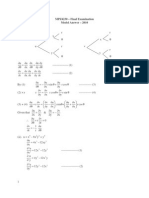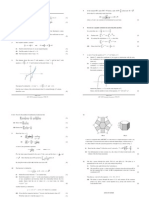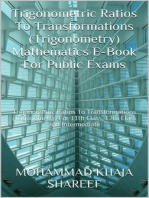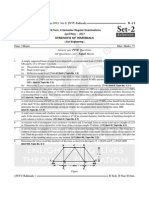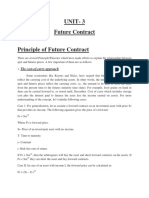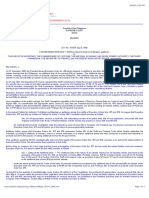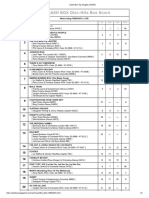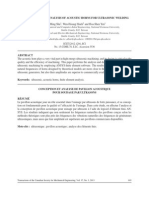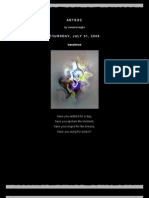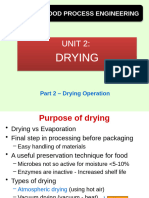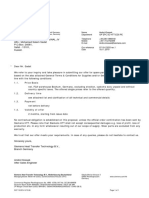Solutions: S - 1 5 Mathematics-III (May-2012, Set-2) JNTU-Kakinada
Solutions: S - 1 5 Mathematics-III (May-2012, Set-2) JNTU-Kakinada
Uploaded by
Sri DCopyright:
Available Formats
Solutions: S - 1 5 Mathematics-III (May-2012, Set-2) JNTU-Kakinada
Solutions: S - 1 5 Mathematics-III (May-2012, Set-2) JNTU-Kakinada
Uploaded by
Sri DOriginal Description:
Original Title
Copyright
Available Formats
Share this document
Did you find this document useful?
Is this content inappropriate?
Copyright:
Available Formats
Solutions: S - 1 5 Mathematics-III (May-2012, Set-2) JNTU-Kakinada
Solutions: S - 1 5 Mathematics-III (May-2012, Set-2) JNTU-Kakinada
Uploaded by
Sri DCopyright:
Available Formats
S.
15
Mathematics-III (May-2012, Set-2) JNTU-Kakinada
Code No: R21016/R10
II B.Tech I Semester Supplementary Examinations
May-2012
Set-2
Solutions
MATHEMATICS - III
( Commom to CE, CHEM, BT, PE )
Time: 3 Hours
Max. Marks: 75
Answer any FIVE Questions
All Questions carry equal marks
---
1.
2.
3.
(a)
d n
[x Jn (x)] = xn Jn 1 (x). (Unit-I, Topic No. 1.1)
dx
(b)
If (x) = 0, if 1 < x < 0
= 1, if 0 < x < 1. (Unit-I, Topic No. 1.2)
(a)
Prove that
1
1 2 tx + t
= P0 (x) + P1 (x)t + P2 (x)t2 + .......... (Unit-I, Topic No. 1.2)
(b)
Write J5/2(x) in finite form. (Unit-I, Topic No. 1.1)
(a)
Determine the analytic function w = u + iv where u =
2 cos x cosh y
given that f(0) = 1.
cos 2 x + cosh 2 y
(Unit-II, Topic No. 2.3.1)
4.
(b)
If cosec + i = u + iv prove that (u2 + v2)2 = 2 (u2 v2). (Unit-III, Topic No. 3.3)
4
(a)
Question not given.
1+ i
(b)
Evaluate
(x y + ix
) dz along
(i)
z = 0 to 1 + i
(ii) The real axis from z = 0 to 1 and then along a line parallel to the imaginary axis from z = 1 to 1 + i.
(Unit-IV, Topic No. 4.1.1)
5.
6.
(a)
Expand cosh z about z = i. (Unit-V, Topic No. 5.1)
(b)
Find the laurent series expansion of the function
(a)
Find the poles of
(b)
Evaluate
z2 1
if 2 < | z | < 3. (Unit-V, Topic No. 5.1)
(z + 2)(z + 3)
e iz
and corresponding residues. (Unit-VI, Topic No. 6.1.1)
z2 + 1
z
(z 1)(z 2)
. dz where C is the circle | z 2 | = 1/2 using residue theorem. (Unit-VI, Topic No. 6.1.2)
WARNING : Xerox/Photocopying of this book is a CRIMINAL act. Anyone found guilty is LIABLE to face LEGAL proceedings.
Spectrum ALL-IN-ONE Journal for Engineering Students, 2012
S.16
2
7.
(a)
Evaluate by residue theorem
2 + cos . (Unit-VI, Topic No. 6.2)
0
(b)
Use the method of contour integration to evaluate
(x
8.
(a)
x2
2
+ a2
dx . (Unit-VI, Topic No. 6.2)
Find the image of the domain in the z-plane to the left of the line z = 3 under the transformation w = z2.
(Unit-VIII, Topic No. 8.1)
(b)
Find the bilinear transformation which transforms the points z = 2, 1, 0 into w = 1, 0, i respectively.
(Unit-VIII, Topic No. 8.2)
WARNING : Xerox/Photocopying of this book is a CRIMINAL act. Anyone found guilty is LIABLE to face LEGAL proceedings.
S.17
Mathematics-III (May-2012, Set-2) JNTU-Kakinada
SOLUTIONS TO MAY-2012, SET-2, Q.P
Q1.
(a)
d n
[x Jn (x)] = xn Jn 1 (x).
dx
If r = 0 c0 = 0 +
May-12, Set-2, Q1(a)
Answer :
For answer refer Unit-I, Q5.
(b)
If (x) = 0, if 1 < x < 0
1
2
= 1, if 0 < x < 1.
P ( x)
0
dx
P ( x)
0
dx
May-12, Set-2, Q1(b)
Answer :
Given that,
1
1 dx
20
f(x) = 0, if 1 < x < 0
= 1, if 0 < x < 1
If f(x) is a polynomial of degree n, then we have,
n
f(x) =
r Pr
( x ) for 1 < x < 1
[Q P0 (x) = 1 from rodrigues formula]
1 1 1
[ x ]0 =
2
2
c0 =
r=0
c0 =
Where, cr = r +
2
f (x) P (x) dx
1
2
... (2)
1
If r = 1 c1 = 1 +
2
f(x) =
r Pr
( x)
r=0
3
2
=
f(x) = c0 P0 (x) + c1 P1 (x) + c2 P2 (x) + c3 P3 (x) + ..... ... (1)
And cr = r +
f (x) P (x) dx
r
1
0
f ( x) Pr ( x)dx + f ( x) Pr ( x )dx
1
= r +
2
0
0.Pr ( x) dx + 1.Pr ( x) dx
1
0
cr = r +
P ( x ) dx
1
[Q From Rodrigues formula, P1 (x) = x]
3 x2
=
2 2
1
Pr ( x ) dx
2
3
x dx
20
= r +
2
P1 ( x ) dx
c1 =
c1 =
3 1
3
0 =
2 2
4
3
4
... (3)
WARNING : Xerox/Photocopying of this book is a CRIMINAL act. Anyone found guilty is LIABLE to face LEGAL proceedings.
Spectrum ALL-IN-ONE Journal for Engineering Students, 2012
S.18
If r = 2 c2 = 2 +
5
=
2
1 1
P2 ( x ) dx
2 0
7 5 3
(0 0)
4 4 2
7 1 7
=
4 4 16
P ( x ) dx
2
5 3x 2 1
=
dx
20 2
C3 =
1 2
Q P2 ( x) = 2 3 x 1
7
16
... (5)
Substituting equations (2), (3), (4) and (5) in equation
(1), we get,
1
3
7
1
p0(x) +
p1(x) + 0. p2(x)
p (x) + ........
16 3
4
2
f(x) =
3
7
1
p0(x) +
p1(x)
p (x) + ........
16 3
4
2
f(x) =
1
3
7 1
(1) + ( x) (5 x 3 3x )
2
4
16 2
5 x3
x
= 3.
4 3
0
f(x) =
5
3 x 2 1 dx
40
5
[(1 1) (0 0)] = 0
4
c2 = 0
... (4)
If r = 3 c3 = 3 +
2
7
=
2
P ( x ) dx
35 x 3 21x
1 3
+ x
2 4
32
16 + 24 x 35 x 3 + 21x
32
35 x 3 + 45 x + 16
32
(35 x 3 45 x 16 )
32
P ( x ) dx
3
7 5x 3 3x
dx Q P3 ( x) = 1 (5 x 3 3x )
20
2
2
1 3
7
+ x
(5x3 3x)
2 4
32
7
5 x 3 3 x dx
40
Q2.
1
7 x4
x2
3.
= 5 .
4 4
2 0
(a)
Prove that
= P0(x) + P1 (x)t
1 2tx + t 2
+ P2 (x)t2 + ..........
Answer :
May-12, Set-2, Q2(a)
For answer refer Unit-I, Q41.
WARNING : Xerox/Photocopying of this book is a CRIMINAL act. Anyone found guilty is LIABLE to face LEGAL proceedings.
S.19
Mathematics-III (May-2012, Set-2) JNTU-Kakinada
(b) Write J5/2(x) in finite form.
Answer :
For answer refer Unit-I, Q19.
Q3.
(a)
Determine the analytic function w = u + iv where u =
May-12, Set-2, Q2(b)
2cos x cosh y
given that f(0) = 1.
cos2x + cosh 2y
May-12, Set-2, Q3(a)
Answer :
Note:The given value of u =
2 cos x cosh y
2 cos x cosh y
is misprinted. It should be u =
cos 2 x + cosh 2 y
cos 2 x + cosh 2 y
Given that,
w= u + iv
f(z) = w = u + i v
The real part of f(z) is,
u=
2 cos x cosh y
... (1)
cos 2 x + cosh 2 y
Differentiating equation (1) with respect to x, we get,
u (cos 2 x + cosh 2 y )(2 sin x cosh y ) (2 cos x cosh y )( sin 2 x.2)
=
x
(cos 2 x + cosh 2 y ) 2
u
(cos 2 x + cosh 2 y )( 2 sin x cosh y ) + ( 2 cos x cosh y )( 2 sin 2 x )
=
x
(cos 2 x + cosh 2 y ) 2
... (2)
Differentiating equation (1), with respect to y, we get,
2
u (cos 2x + cosh y)(2 cos x sinh y) (2 cos x cosh y)(2 cosh y sinh y)
=
y
(cos 2 x + cosh2 y) 2
... (3)
The analytic function,
f(z) = u + i v
=
u
v
+i
x
x
u u
+ i
x y
v u
Q From C R equations
=
x
y
f'(z) =
u
u
i
x
y
f'(z) =
(cos 2 x + cosh 2 y )(2 sin x cosh y ) + ( 2 cos x cosh y )( 2 sin 2 x)
(cos 2 x + cosh 2 y ) 2
(cos 2 x + cosh 2 y )(2 cos x sinh y ) ( 2 cos x cosh y ) 2 cosh y sinh y
i
(cos 2 x + cosh 2 y ) 2
WARNING : Xerox/Photocopying of this book is a CRIMINAL act. Anyone found guilty is LIABLE to face LEGAL proceedings.
Spectrum ALL-IN-ONE Journal for Engineering Students, 2012
S.20
By Milne-Thomsons method replace x by z and y by 0.
f '(z) =
(cos 2 z + cosh 2 (0))(2 sin z cosh( 0)) + ( 2 cos z cosh( 0))( 2 sin 2 z )
(cos 2 z + cosh 2 (0)) 2
(cos 2 z + cosh 2 (0))(2 cos z sinh( 0)) ( 2 cos z cosh( 0)) 2 cosh( 0) sinh( 0)
i
(cos 2 z + cosh 2 (0)) 2
f '(z) =
(cos 2 z + 1)(2 sin z ) + (2 cos z )(2 sin 2 z ) i (cos 2 z + 1)(0) (2 cos z )(0)
(cos 2 z + 1) 2
(cos 2 z + 1) 2
f '(z) =
(cos 2 z + 1)(2 sin z ) + 4 sin 2 z cos z
(cos 2 z + 1) 2
(cos 2 z + 1)(2 sin z ) + 4( 2 sin z cos z ) cos z
(cos 2 z + 1) 2
(cos 2 z + 1)(2 sin z ) + 4 sin z (2 cos 2 z )
(cos 2 z + 1) 2
(cos 2 z + 1)(2 sin z ) + 4 sin z (1 + cos 2 z )
(cos 2 z + 1) 2
[Q 2 cos2 = 1 + cos 2 ]
(cos 2 z + 1)(2 sin z + 4 sin z )
(cos 2 z + 1) 2
2 sin z
cos 2 z + 1
2 sin z
sin z
=
2 cos 2 z cos 2 z
sin z
1
cos z cos z
f '(z) = tan z sec z
On integrating the above equation, we get,
f(z) =
sec z tan zdz
f(z) = sec z + C
... (4)
WARNING : Xerox/Photocopying of this book is a CRIMINAL act. Anyone found guilty is LIABLE to face LEGAL proceedings.
S.21
Mathematics-III (May-2012, Set-2) JNTU-Kakinada
Given, f(0) = 1
Substitute Z = 0 in equation (4), we get,
f(0) = Sec (0) + C
1= 1 + C
C= 0
Substituting C = 0 in equation (4), we get,
f(z) = sec z
If cosec + i = u + iv prove that (u2
4
2
2
2
+ v ) = 2 (u v2).
Answer :
May-12, Set-2, Q3(b)
Note:In the given problem, the L.H.S side is misprinted
Given that,
2[sin x cosh y i cos x sinh y]
cosh 2 y cos 2x
1
cosh i
sinh
2
2
2
=
cosh 2 0
1
sin(x + iy )
2[cosh i sinh ]
cosh 2 0
cosh
sinh
i 2
= 2
cosh 2
cosh 2
sin x cosh y i cos x sinh y
u=
sin x cosh y i cos x sinh y
(sin x cosh y) 2 (i cos x sinh y) 2
sin x cosh y i cos x sinh y
sin 2 x cosh 2 y + cos 2 x sinh 2 y
2[sin x cosh y i cos x sinh y ]
u2 = 2
u2 +v2 = 2
; v2 = 2
sinh 2
cosh 2 2
cosh 2
cosh 2
2
+2
sinh 2
cosh 2 2
[2 cosh 2 1] + [2 sinh 2 + 1]
cosh 2 2
2[cosh y cos 2 x cosh2 y + cos 2 x sinh2 y]
2 cosh 2 y 2 cos 2 x(cosh 2 y sinh 2 y )
cosh 2
2
sinh
cosh 2
2 cosh 2 + 2 sinh 2
cosh 2 2
2[sin x cosh y i cos x sinh y]
cosh 2
2[(1 cos 2 x cosh 2 y + cos 2 x sinh 2 y]
2[sin x cosh y i cos x sinh y]
cosh
;v=
cosh 2
Now,
2[sin 2 x cosh 2 y + cos 2 x sinh 2 y]
2[sin x cosh y i cos x sinh y]
2[sin x cosh y i cos x sinh y]
cosh 2 y cos 2x
2[sin([ / 4) cosh i cos / 4 sinh ]
cosec + j =
cosh 2 cos 2( / 4)
4
= sin x cosh y + i cos x sinh y sin x cosh y i cos x sinh y
=
[2 cosh 2 y 1] [2 cos 2 x 1]
cosec (x + iy) =
1
sin x cos h y + i cos x sinh y
1
2[sin x cosh y i cos x sinh y]
[Q cos 2 = 2cos2 1, cosh 2 = 2cosh2 1]
cosec + i = u + iv
4
We know that,
sin (x + iy) = sinx coshy + i cosx sinhy
cosec (x + iy) =
2 cosh 2 y 2 cos 2 x
[Q cosh2 y sinh2 y = 1]
(b)
as cosec + i . It should be cosec + i .
4
4
2[sin x cosh y i cos x sinh y]
[cosh 2 ] + [cosh 2 ]
cosh 2 2
[Q cosh2 = 2cosh21 = 2sinh2 + 1]
WARNING : Xerox/Photocopying of this book is a CRIMINAL act. Anyone found guilty is LIABLE to face LEGAL proceedings.
Spectrum ALL-IN-ONE Journal for Engineering Students, 2012
S.22
=
2 cosh 2
Q5.
(a)
cosh 2 2
Answer :
Expand cosh z about z = i.
May-12, Set-2, Q5(a)
Given that,
cosh 2
= 2
cosh 2 2
f(z) = cosh z
and z = i
Put z = i = t
cosh 2
= 2
2
(u2 + v2)2 =
cosh 2
=
z =t+i
f (z) = cosh (t) cosh ( i) + sinh (t) sinh ( i)
...(1)
Cosh ( i) =
cosh 2
2
Now,
cosh 2 sinh
cosh 2 2 cosh 2 2
u2 v2 = 2
y cosh x =
2[cosh 2 sinh 2 ]
cosh 2 2
=
2
cosh 2
cosh 2
=
+
v2)2 =
(a)
2
cos + i sin + cos i sin
2
2 cos
=1
2
4
cosh2 2
2
(u2
Sinh ( i) =
v2)
Question not given.
e i e i
2
(cos + i sin ) (cos i sin )
2
May-12, Set-2, Q4(a)
Answer :
Since the question is not given, answer is not provided.
1+i
(b)
(cos + i sin ) + (cos i sin )
Hence proved.
Q4.
e x e x
ex + ex
and sinh x =
)
2
2
2(u2 v2) = 2
e i + e i
2
( cosh (x + y) = cosh x cosh y + sinh x sinh
2
(u2
f (z) = cosh (t + i)
Evaluate
cos + i sin cos + i sin
2
2i sin
= i sin = 0
2
(x y + ix ) dz along,
2
(i) z = 0 to 1 + i
(ii) The real axis from z = 0 to 1 and
then along a line parallel to the
imaginary axis from z = 1 to 1 + i.
May-12, Set-2, Q4(b)
Answer :
For answer refer Unit-IV, Q9.
Substitute cosh i and sin i in equation (1), we get,
f (z) = cosh t (1) + sinh t(0)
f (z) = cosh t + 0
f (z) = cosh t
WARNING : Xerox/Photocopying of this book is a CRIMINAL act. Anyone found guilty is LIABLE to face LEGAL proceedings.
S.23
Mathematics-III (May-2012, Set-2) JNTU-Kakinada
We know that,
x4
x2
+
+ ........
4!
2!
cosh x = 1+
A=3
t
t
f (z) = cosh t = 1 + + + + .....
2! 4! 6!
Put z = 2 in equation (2), we get,
( 2)2 1= (2 + 2 ) ( 2 + 3) + A ( 2 + 3) + B ( 2 + 2)
4 1 = 0 + A (1) + 0
Put z = 3 in equation (2), we get,
(3)2 1 = ( 3 + 2) ( 3 + 3) + A ( 3 + 3) + B ( 3 + 2)
9 1 = 0 + 0 + B ( 1)
B =8
(z i )2 (z i )4
+
+ .....
= 1 +
2!
4!
B = 8
Substitute A and B values in equation (1) we get,
( z i ) 2 n
=
n =0
2n!
cosh z at z = i is
n =0
(b)
z 2 1
3
8
=1+
(z + 2)(z + 3)
z+2
z +3
( z i ) 2 n
2n!
=1+
Find the laurent series expansion of the
function
z2 1
if 2 < | z | < 3.
(z + 2)(z + 3)
[ 2 < | z | < 3
May-12, Set-2, Q5(b)
Answer :
Given that,
f (z) =
3 2
1 +
z z
=1+
3
z
Coefficient of highest power in numerator
Coefficient of highest power in denominator
=1+
z 2 1
(z + 2)(z + 3)
The given fraction is an improper fraction as degree
of numerator is degree of denominator
= 1+
1
=1
1
Now the partial, for the given fraction function
becomes,
3
8
2
z
z 1 +
31 +
z
3
f (z) = 1 +
z
8
1 +
3
3
2 2 2 2 3
1 + + .....
z z
Z
z z 2 z 3
1 + + .....
3 3 3
n
n
8
3
( 1)n 2
( 1)n z
3 n= 0
z n= 0
3
z
n
A
B
+
z +3
z+2
z 2 1
A
B
=1+
+
(z + 2)(z + 3)
z +3
z+2
2
|z|
< 1 and
<1
|z|
3
2 8
3
z
( 1)n ( 1)n
f (z) = 1 +
z 3 n= 0
z n =0
3
This is the required laurent series.
Q6.
... (1)
z2 1= (z + 2) (z + 3) + A (z + 3) + B (z + 2) ... (2)
(a)
Find the poles of
e iz
and corresponding
z2 + 1
residues.
Answer :
For answer refer Unit-VI, Q8.
May-12, Set-2, Q6(a)
WARNING : Xerox/Photocopying of this book is a CRIMINAL act. Anyone found guilty is LIABLE to face LEGAL proceedings.
Spectrum ALL-IN-ONE Journal for Engineering Students, 2012
S.24
(b)
Evaluate
After substituting the above values in equation (1),
(z 1)(z 2)
.dz where C is
the circle | z 2 | = 1/2 using residue
theorem.
May-12, Set-2, Q6(b)
Answer :
For answer refer Unit-VI, Q17
Q7.
(a)
Evaluate by residue theorem
2
2 + cos 4
Use the method of contour integration
to evaluate
(x
x
2
( w 1) (i) ( z 2)
=
z
(i w)
i iw 2 z
=
iw
z
zi iwz = 2i 2w z i + wz
zi + zi 2i = iwz 2w + wz
For answer refer Unit-VI, Q42.
(b)
( w 1) (0 i ) ( z 2) (1 0)
=
(1 0) (i w) (2 1) (0 z )
(i iw)z = (i w) (2 z)
May-12, Set-2, Q7(a)
Answer :
we get,
2iz 2i = w(iz 2 + z)
2iz 2i = w(z(i + 1) 2)
+ a2
dx .
w=
May-12, Set-2, Q7(b)
Answer :
2iz 2i
( z (i + 1) 2)
Which is the required transformation.
For answer refer Unit-VI, Q30.
Q8.
(a)
Find the image of the domain in the zplane to the left of the line z = 3 under
the transformation w = z2.
Answer :
May-12, Set-2, Q8(a)
Note: In the given problem, x = 3 is misprinted as z
=3
For answer refer Unit-VIII, Q17.
(b)
Find the bilinear transformation which
transforms the points z = 2, 1, 0 into w =
1, 0, i respectively.
Answer :
May-12, Set-2, Q8(b)
Given that,
z = 2, 1, 0 and
w = 1, 0, i
The bilinear transformation is,
( w4 w1 ) (w2 w3 )
( z z ) (z z )
= 4 1 2 3
( w1 w2 ) (w3 w4 )
( z1 z 2 ) ( z 3 z 4 )
... (1)
Let,
z1 = 2,
z2 = 1, z3 = 0, and z4 = z
w1 = 1
w2 = 0, w3 = i and w4 = w
WARNING : Xerox/Photocopying of this book is a CRIMINAL act. Anyone found guilty is LIABLE to face LEGAL proceedings.
You might also like
- Fedora Terminal CommandsDocument17 pagesFedora Terminal CommandsMohammed Abdul NadeemNo ratings yet
- 2007 Ajc h2 Prelims Paper 1 SolutionsDocument9 pages2007 Ajc h2 Prelims Paper 1 Solutionsvincesee85No ratings yet
- NYJC JC 2 H2 Maths 2011 Mid Year Exam Solutions Paper 1Document10 pagesNYJC JC 2 H2 Maths 2011 Mid Year Exam Solutions Paper 1jimmytanlimlongNo ratings yet
- Botswana - Guideline 5 - Planning and Environmental Impact (2001)Document108 pagesBotswana - Guideline 5 - Planning and Environmental Impact (2001)وردة حزيرانNo ratings yet
- MIDTERM MTH3112 Sem1!16!17 Solution Nov16Document7 pagesMIDTERM MTH3112 Sem1!16!17 Solution Nov16Nik Muhd AriffNo ratings yet
- 2010 DHS Paper 1solDocument10 pages2010 DHS Paper 1solnothingtodo1992No ratings yet
- Engineering MathsDocument8 pagesEngineering MathsSanthosh SanNo ratings yet
- Final ExamDocument14 pagesFinal ExamIwan M SyariefuddinNo ratings yet
- Narayana Institute Iit Jee 2008 Paper 1 2Document53 pagesNarayana Institute Iit Jee 2008 Paper 1 2Pranjal AgarwalNo ratings yet
- Model Answer For Combined Mathematics I - 2013 AL Paper PDFDocument18 pagesModel Answer For Combined Mathematics I - 2013 AL Paper PDFThiwanka De SilvaNo ratings yet
- E.D. Reducibles A Variable SeparableDocument14 pagesE.D. Reducibles A Variable Separableelvis_3343No ratings yet
- Ex 3 2 FSC Part2 Ver214Document5 pagesEx 3 2 FSC Part2 Ver214adnanNo ratings yet
- RT Solutions-22!01!2012 XIII VXY Paper II Code A SolDocument16 pagesRT Solutions-22!01!2012 XIII VXY Paper II Code A Solvishal110085No ratings yet
- 2014 2 JOHOR SMK Dato Jaafar JohorBahru MATHS ADocument3 pages2014 2 JOHOR SMK Dato Jaafar JohorBahru MATHS ASKNo ratings yet
- Answers 2009-10Document19 pagesAnswers 2009-10Yoga RasiahNo ratings yet
- DeMoivres TheoremDocument25 pagesDeMoivres TheorembigaNo ratings yet
- 12th Maths Exam Paper (2008-2012) FinalDocument430 pages12th Maths Exam Paper (2008-2012) FinalAdityas AravindNo ratings yet
- Formula TableDocument1 pageFormula TableAho Chi- ShuenNo ratings yet
- Unit 2 Module Tests AnswersDocument28 pagesUnit 2 Module Tests AnswersashtigosineNo ratings yet
- © Science Exam Papers: Worked Solutions Edexcel C4 Paper IDocument3 pages© Science Exam Papers: Worked Solutions Edexcel C4 Paper IPa GesNo ratings yet
- 2008 Ext1 PDFDocument3 pages2008 Ext1 PDFBrandi RoseNo ratings yet
- 2015 AJC Prelim Paper 1 QnsDocument7 pages2015 AJC Prelim Paper 1 QnsYing Ru ChuaNo ratings yet
- Final Exam Set ADocument17 pagesFinal Exam Set AAtikah J100% (1)
- C D I 2 L E - D: X X X F X X X X FDocument0 pagesC D I 2 L E - D: X X X F X X X X Fglobaltech164768No ratings yet
- MA1201 Tutorial Unit1 2 12 13Document4 pagesMA1201 Tutorial Unit1 2 12 13Krishna sahNo ratings yet
- Section FDocument9 pagesSection FkaivalyaNo ratings yet
- Answer To Odd ProblemsDocument18 pagesAnswer To Odd ProblemsSingh KaranNo ratings yet
- All India Test Series: Target Iit-JeeDocument12 pagesAll India Test Series: Target Iit-JeeasuhassNo ratings yet
- Section G: Integer Answer Type: X FX F XDocument10 pagesSection G: Integer Answer Type: X FX F XsatwiksmNo ratings yet
- XII Mathematics IIT JEE Advanced Study Package 2014 15 PDFDocument322 pagesXII Mathematics IIT JEE Advanced Study Package 2014 15 PDFNarayanan MadhavanNo ratings yet
- AIEEE Maths ShortcutFormulaeDocument1 pageAIEEE Maths ShortcutFormulaeAkash JoshiNo ratings yet
- CalA - 6 - 2 PDFDocument8 pagesCalA - 6 - 2 PDFGeorge Leon RibeiroNo ratings yet
- Kvadrat BinomaDocument0 pagesKvadrat BinomaAleksandar JerinicNo ratings yet
- II Sem (Csvtu) Mathematics Unit 2 (Linear Differential Equation) SolustionsDocument31 pagesII Sem (Csvtu) Mathematics Unit 2 (Linear Differential Equation) SolustionsMrityunjoy DuttaNo ratings yet
- Iit - Jee Model Grand Test - Ii Paper - 1 SolutionsDocument6 pagesIit - Jee Model Grand Test - Ii Paper - 1 SolutionsSayan Kumar KhanNo ratings yet
- Mathematics Sample Paper Solutions Section-ADocument19 pagesMathematics Sample Paper Solutions Section-APoonamBhardwajNo ratings yet
- Hints/Solutions For M1208: (Differential Equations)Document8 pagesHints/Solutions For M1208: (Differential Equations)Sivakumar NatarajanNo ratings yet
- 2014 2 Sar Tun Abdul RazakDocument4 pages2014 2 Sar Tun Abdul RazakMasytah YazidNo ratings yet
- Fiitjee Mock PaperDocument25 pagesFiitjee Mock PaperShashank ShekharNo ratings yet
- Common Practice Test - 5 Jee Mains: Matheamtics SolutionDocument8 pagesCommon Practice Test - 5 Jee Mains: Matheamtics Solutionblue_l1No ratings yet
- Cumulative Test-2 (Ct-2) : Hints & SolutionsDocument15 pagesCumulative Test-2 (Ct-2) : Hints & SolutionsultimatorZNo ratings yet
- Text 1b emDocument13 pagesText 1b emkrishNo ratings yet
- De Moiver's Theorem (Trigonometry) Mathematics Question BankFrom EverandDe Moiver's Theorem (Trigonometry) Mathematics Question BankNo ratings yet
- Analytic Geometry: Graphic Solutions Using Matlab LanguageFrom EverandAnalytic Geometry: Graphic Solutions Using Matlab LanguageNo ratings yet
- Trigonometric Ratios to Transformations (Trigonometry) Mathematics E-Book For Public ExamsFrom EverandTrigonometric Ratios to Transformations (Trigonometry) Mathematics E-Book For Public ExamsRating: 5 out of 5 stars5/5 (1)
- Factoring and Algebra - A Selection of Classic Mathematical Articles Containing Examples and Exercises on the Subject of Algebra (Mathematics Series)From EverandFactoring and Algebra - A Selection of Classic Mathematical Articles Containing Examples and Exercises on the Subject of Algebra (Mathematics Series)No ratings yet
- Transformation of Axes (Geometry) Mathematics Question BankFrom EverandTransformation of Axes (Geometry) Mathematics Question BankRating: 3 out of 5 stars3/5 (1)
- Inverse Trigonometric Functions (Trigonometry) Mathematics Question BankFrom EverandInverse Trigonometric Functions (Trigonometry) Mathematics Question BankNo ratings yet
- 10+2 Level Mathematics For All Exams GMAT, GRE, CAT, SAT, ACT, IIT JEE, WBJEE, ISI, CMI, RMO, INMO, KVPY Etc.From Everand10+2 Level Mathematics For All Exams GMAT, GRE, CAT, SAT, ACT, IIT JEE, WBJEE, ISI, CMI, RMO, INMO, KVPY Etc.No ratings yet
- Differentiation (Calculus) Mathematics Question BankFrom EverandDifferentiation (Calculus) Mathematics Question BankRating: 4 out of 5 stars4/5 (1)
- Mathematics 1St First Order Linear Differential Equations 2Nd Second Order Linear Differential Equations Laplace Fourier Bessel MathematicsFrom EverandMathematics 1St First Order Linear Differential Equations 2Nd Second Order Linear Differential Equations Laplace Fourier Bessel MathematicsNo ratings yet
- Application of Derivatives Tangents and Normals (Calculus) Mathematics E-Book For Public ExamsFrom EverandApplication of Derivatives Tangents and Normals (Calculus) Mathematics E-Book For Public ExamsRating: 5 out of 5 stars5/5 (1)
- Complex Numbers (Trigonometry) Mathematics Question BankFrom EverandComplex Numbers (Trigonometry) Mathematics Question BankNo ratings yet
- Logical progression of twelve double binary tables of physical-mathematical elements correlated with scientific-philosophical as well as metaphysical key concepts evidencing the dually four-dimensional basic structure of the universeFrom EverandLogical progression of twelve double binary tables of physical-mathematical elements correlated with scientific-philosophical as well as metaphysical key concepts evidencing the dually four-dimensional basic structure of the universeNo ratings yet
- SSC Je FM 2019Document8 pagesSSC Je FM 2019Sri DNo ratings yet
- Kutra Prabhakar JaineDocument153 pagesKutra Prabhakar JaineSri DNo ratings yet
- Idioms and Phrases by - Tarun Grover "A": To Get 10 % Off On Unacademy Plus Use Referral Code - TARUN - SIRDocument73 pagesIdioms and Phrases by - Tarun Grover "A": To Get 10 % Off On Unacademy Plus Use Referral Code - TARUN - SIRSri DNo ratings yet
- Survey IAS Questions PDFDocument24 pagesSurvey IAS Questions PDFSri DNo ratings yet
- Sentence ImprovementDocument26 pagesSentence ImprovementSri DNo ratings yet
- JPSC Ae 2019 Pre Civil 19.01.2020 JcaDocument15 pagesJPSC Ae 2019 Pre Civil 19.01.2020 JcaSri DNo ratings yet
- SA IAS QuestionsDocument12 pagesSA IAS QuestionsSri DNo ratings yet
- CE6501 Structural Analysis I Unit 2Document12 pagesCE6501 Structural Analysis I Unit 2Sri DNo ratings yet
- 02-04 Chap GereDocument12 pages02-04 Chap GereSri DNo ratings yet
- 2770-ST7103-Theory of Elasticity and PlasticityDocument11 pages2770-ST7103-Theory of Elasticity and PlasticitySri D50% (2)
- DdhsDocument4 pagesDdhsSri DNo ratings yet
- Strength of Materials 2-2 Set-2 (K)Document12 pagesStrength of Materials 2-2 Set-2 (K)Sri DNo ratings yet
- Ce Sol PDFDocument5 pagesCe Sol PDFSri DNo ratings yet
- Jntu Hyd 3 2 It Embsys Set 1Document5 pagesJntu Hyd 3 2 It Embsys Set 1Sri DNo ratings yet
- Strength of Materials-II 2-2 Set-3 (A)Document18 pagesStrength of Materials-II 2-2 Set-3 (A)Sri DNo ratings yet
- Strength of Materials-II 2-2 Set-2 (A)Document13 pagesStrength of Materials-II 2-2 Set-2 (A)Sri DNo ratings yet
- Strength of Materials-II 2-2 Set-4 (A)Document10 pagesStrength of Materials-II 2-2 Set-4 (A)Sri DNo ratings yet
- BE OU FirstYear EnggGraph May June 12Document12 pagesBE OU FirstYear EnggGraph May June 12Sri DNo ratings yet
- Hyd It 3 1 CN Set 4Document8 pagesHyd It 3 1 CN Set 4Sri DNo ratings yet
- Strength of Materials-II 2-2 Set-1 (A)Document18 pagesStrength of Materials-II 2-2 Set-1 (A)Sri D50% (2)
- After 20 Years 3 PDFDocument7 pagesAfter 20 Years 3 PDFSri DNo ratings yet
- Unit 03 - Future Contract - Principle of Future ContractDocument6 pagesUnit 03 - Future Contract - Principle of Future ContractAugusto SaavedraNo ratings yet
- Honolulu Standard-Details-Public-Works-Construction-2000 PDFDocument207 pagesHonolulu Standard-Details-Public-Works-Construction-2000 PDFEddie Rivas ArendsNo ratings yet
- Garcia V Executive SecretaryDocument4 pagesGarcia V Executive SecretaryJMVNo ratings yet
- Restaurant Management Resources: The BasicsDocument2 pagesRestaurant Management Resources: The BasicsLaura RomanNo ratings yet
- Quiz 1 Operation ManagementDocument9 pagesQuiz 1 Operation ManagementSaja BassamNo ratings yet
- Cash Box Top Singles 2 - 04 - 50Document2 pagesCash Box Top Singles 2 - 04 - 50David SkidgelNo ratings yet
- Anglo Saxon LiteratureDocument32 pagesAnglo Saxon LiteratureAzad RahmanNo ratings yet
- BIMA BBS RegisterDocument47 pagesBIMA BBS Registeraminamin.200029No ratings yet
- HPGD2303 Educational AssessmentDocument24 pagesHPGD2303 Educational Assessmentyanidevi030No ratings yet
- Mvaj101 - Trip RelayDocument2 pagesMvaj101 - Trip Relayratheeshkumard100% (1)
- Solutions To Exercises Exercise 18-1-15Document50 pagesSolutions To Exercises Exercise 18-1-15Aiziel OrenseNo ratings yet
- Fenton Stream Function TheoryDocument12 pagesFenton Stream Function TheoryElendu Emmanuel ChigozieNo ratings yet
- Design and Analysis of Acoustic Horns For Ultrasonic WeldingDocument12 pagesDesign and Analysis of Acoustic Horns For Ultrasonic WeldingMiguel HernandezNo ratings yet
- Artsoc: by Veneeta SinghaDocument26 pagesArtsoc: by Veneeta Singhaveneeta singhaNo ratings yet
- 2 OpenBAS-HV-NX10 Installation ManualDocument45 pages2 OpenBAS-HV-NX10 Installation ManualLuis OrozcoNo ratings yet
- Review of Related Literature and Related StudyDocument9 pagesReview of Related Literature and Related StudyJustine Latorre MoraldeNo ratings yet
- FPE - Unit 2 - Part 2 - Drying - Principles & Rate CurveDocument45 pagesFPE - Unit 2 - Part 2 - Drying - Principles & Rate CurvevenkateshNo ratings yet
- BPS6 - Report Engine Scalability and PerformanceDocument5 pagesBPS6 - Report Engine Scalability and PerformanceLilyNo ratings yet
- 1 The - Thirty-One - Functions - in - Vladimir - Propps - MorphDocument12 pages1 The - Thirty-One - Functions - in - Vladimir - Propps - MorphNurul FatimahNo ratings yet
- Explain The Major Indicators of DevelopmentDocument2 pagesExplain The Major Indicators of DevelopmentTrust ChiradzaNo ratings yet
- Synopsis-URBAN FOOD HUB AND VERTICAL FARMINGDocument4 pagesSynopsis-URBAN FOOD HUB AND VERTICAL FARMINGKalyani ParkhiNo ratings yet
- Indian Economy (Up To 1200) FinalDocument262 pagesIndian Economy (Up To 1200) Finalun3709579No ratings yet
- Intermediate Accounting: Investments and Long-Term ReceivablesDocument31 pagesIntermediate Accounting: Investments and Long-Term ReceivablesKurtNo ratings yet
- TNB Remaco - Kharafi National JV Attn.: Mohamed Salem Sadat P.O.Box: 24081, Safat - 13101, KuwaitDocument9 pagesTNB Remaco - Kharafi National JV Attn.: Mohamed Salem Sadat P.O.Box: 24081, Safat - 13101, KuwaitRnldo de CabrioNo ratings yet
- 8044 eDocument6 pages8044 ePreet ShahNo ratings yet
- Lesson Plan in Special-TopicsDocument4 pagesLesson Plan in Special-TopicsApril Grace Genobatin BinayNo ratings yet
- IPAL Fish ProcessingDocument1 pageIPAL Fish ProcessingSaktiSiregar99No ratings yet














